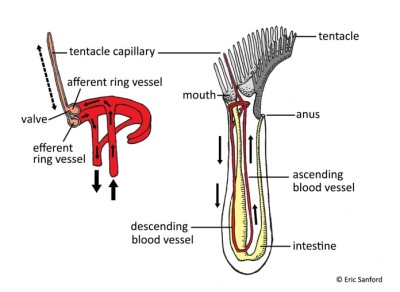Last summer, I was fortunate to observe some phoronids (Phoronis vancouverensis) on the outer coast of Bodega Head (Figure 1). These striking marine invertebrates belong to their own phylum, Phoronida, which contains only 12–14 species in the world! These are small, worm-like animals that use their elegant, u-shaped crown of ciliated tentacles (called a lophophore) for suspension feeding. Phytoplankton and other food particles are captured on their tentacles and are transported downward to the mouth, which lies in the center of the tentacles (Pearse et al. 1987). The anterior crown of tentacles is usually the only part of the animal visible; the trunk of the long, worm-like body lies hidden in a tube that extends down into the surrounding sediments.
As I watched one phoronid feeding under the microscope, I found myself mesmerized by the rhythmic movements of a red fluid visible within the transparent tentacles of the animal. The fluid would rise up the length of a tentacle, pause for a second or two, and then rapidly ebb out of the tentacle. In the photograph below (Figure 2), the red fluid is particularly noticeable in the tentacles near the center. The ebb and flow of the fluid appeared to be largely unsynchronized in adjacent tentacles.
What was this mysterious red fluid moving within the tentacles of the phoronid? As you might have guessed, the fluid was blood! Like humans, phoronids have red blood corpuscles that contain hemoglobin, a respiratory pigment used for transporting oxygen throughout the body. However, as I watched under the microscope, the blood of phoronids appeared to just rise and fall repeatedly within the short length of each tentacle. Up…and down. Up…and down. I was puzzled: this seemed like a “circulatory” system where the blood didn’t circulate?! So I decided I needed to learn more about how this system works.
It turns out that phoronids have a circulatory system consisting of two major longitudinal vessels – one ascending and one descending (Figure 3). Phoronids lack a heart, but rhythmic contractions of strong muscles in the walls of the ascending vessel force blood upward via peristalsis (Emig 1982). Blood enters the afferent ring vessel, and from there, a single capillary passes into each tentacle and dead ends near the tip of the tentacle. The blood remains stationary within the tentacle for one or two seconds where it picks up oxygen from the surrounding water via diffusion across the thin wall of the tentacle. Then, strong muscular contractions in the capillary wall reverse the flow of blood and force it out of the tentacle. A tiny, one-way flap valve at the base of the tentacle now shunts the oxygenated blood into the efferent ring vessel, which leads to the descending blood vessel (Emig 1982). Thus, although it might appear at first that the same blood is sloshing back and forth within each tentacle, in reality, each capillary is continuously receiving different parcels of deoxygenated blood that are reloaded with oxygen and sent on their way!

Figure 3. The circulatory system of a phoronid. Arrows indicate the direction of blood flow. The inset (left) shows an enlargement of the anterior end of the circulatory system. For simplicity, only one of the tentacular capillaries is illustrated. Figure modified and redrawn by the author based on several sources (Pearse et al. 1987, Vandergon & Colacino 1991).
This unique circulatory system appears to be an adaptation that permits some phoronids to live in habitats where their tubes are completely surrounded by anoxic sediments (Vandergon & Colacino 1991). The tentacles essentially function both as feeding structures and as gills. Because the lophophore extends above the surface of the sediments, it is well suited to gathering oxygen from the water. Indeed, measurements confirm that hemoglobin is fully loaded with oxygen while the blood is in the tentacles, and then oxygen is lost steadily as the blood descends through the body (Vandergon & Colacino 1991).
Interestingly, predators such as fish and crabs sometimes nip off the lophophores of phoronids (Larson & Stachowicz 2009)! Although phoronids often survive these attacks and regenerate their missing lophophore, this process can take over a week (Larson & Stachowicz 2009). Given the critical role that the tentacles play in maintaining aerobic respiration, one is left to wonder how these animals survive so long without their lophophore?
Photos used with permission from Jackie Sones.
References:
Emig, C.C. (1982) The biology of Phoronida. Advances in Marine Biology 19: 1–89.
Larson. A.A. & J.J. Stachowicz (2009) Chemical defense of a soft-sediment dwelling phoronid against local epibenthic predators. Marine Ecology Progress Series 374: 101–111.
Pearse, V., J. Pearse, M. Buchsbaum, & R. Buchsbaum (1987) Living Invertebrates. The Boxwood Press, Pacific Grove, CA.
Vandergon, T.L. & J.M. Colacino (1991) Hemoglobin function in the Lophophorate Phoronis architecta (Phoronida). Physiological Zoology 64: 1561–1577.

